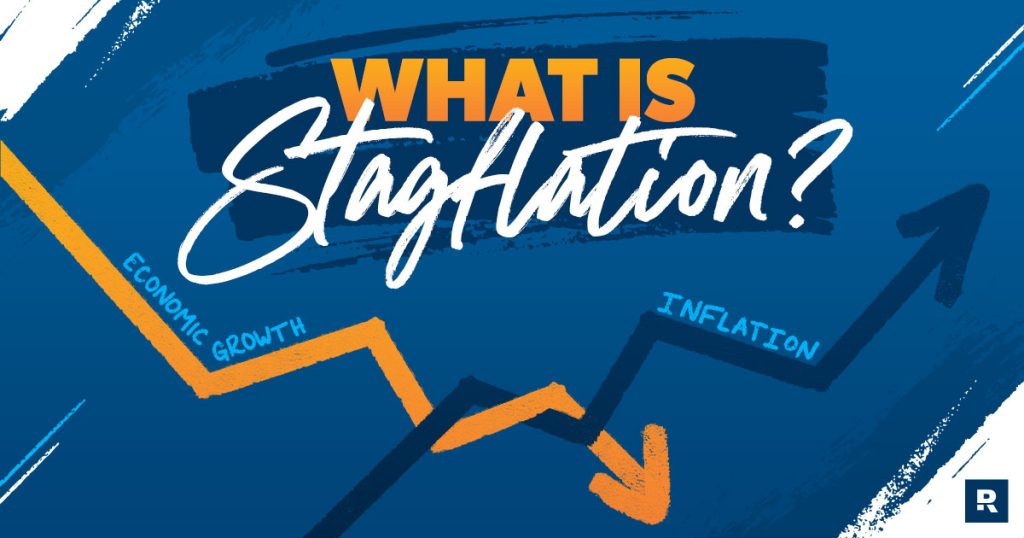If you want to send shivers down an economist’s spine, all you have to do is say one strange-sounding word—stagflation.
Nope, we’re not talking about a boom in the population of male deer. Instead, we’re talking about an economic term that’s used to describe an unlikely combination of economic conditions: a stagnant (or struggling) economy and a rise in the prices of goods and services across the board (aka inflation).
So, when you combine economic stagnation with high inflation, you get stagflation! Get it? (Yeah, not quite as funny as combining hungry and angry to make hangry.)
While we haven’t seen this depressing one-two punch since the 1970s, more and more economists are sounding the alarm that we might be heading toward another period of stagflation. Why? Because inflation is at a 40-year high and the economy is slowing.
But we’re not there yet. So let’s break down what stagflation is, what causes it, and look back at stagflation’s past before trying to figure out whether history will repeat itself.
What Is Stagflation?
Stagflation is an economic term that describes when economic growth is slow or negative and inflation and unemployment are high. Just so you know, economic growth is measured by gross domestic product, which is the sum of all goods and services produced by the economy.
Stagflation is pretty rare, though. Normally, when the economy is growing fast, inflation goes up. Makes sense, right? Businesses are humming along, profits are up, and people have more money to spend—so consumer demand causes prices to increase.
On the other hand, when the economy is growing slower, inflation is usually lower because people have less money to spend.
Stagflation spits in the face of all those normal assumptions. And when you have a stagnant economy and out-of-control inflation happening at the same time, it creates a nasty cocktail of economic conditions that leaves everyone feeling a bit woozy.
When an economy slows, that leads to fewer jobs and higher unemployment. So folks have less money to spend on stuff that costs more due to inflation.
What Are the Causes of Stagflation?
There are lots of theories out there about what causes stagflation, but they mostly boil down to two factors when you get through it all: government policies and sudden changes in the supply of important commodities (like oil).
Government Policy
Sometimes, when the government tries to get involved in something, they end up making things worse. Shocking, we know.
In an effort to get a slow economy moving, the government might try to increase the money supply by printing more money or by making it easier to borrow money by lowering interest rates. But the problem is, at some point, there might be too many dollars out there and not enough goods. And what happens when supply can’t meet demand? Stupid-high inflation.
And if the government’s policies don’t get the economy going, you’re stuck with stagflation.
On the other hand, the government might increase interest rates and reduce the money supply to fight inflation (which it’s doing now). One bad side effect of increasing interest rates is that it slows down the economy. So if inflation keeps on going, you could end up with stagflation.
Supply Shock
Another way stagflation might rear its ugly head has to do with an unexpected drop in the supply of an important product or commodity, especially something like oil. That’s also known as a supply shock, and it could spark a domino effect that leads to a sudden rise in prices throughout the economy (especially for things like gas and food).
Start budgeting with EveryDollar today!
Supply shortages often make it more expensive to produce certain goods and to transport them from place to place. To make up for those rising costs, companies might raise the price of what they’re selling, lay off some of their employees, or use a combination of both. Yikes!
Examples of Stagflation
For the longest time, people thought stagflation wasn’t really possible. After all, how can prices go up if the economy was stalled or even shrinking? When people have less money to spend, consumer demand drops . . . and prices usually drop with that falling demand.
But then the 1970s happened. While disco and bell-bottom jeans were all the rage, there was a toxic combination of events and economic factors that led to a period of stagflation (dun-dun-dun).
Here’s what happened: In the early ’70s, oil prices skyrocketed because of an oil embargo, and that made it more expensive to produce goods and transport them to where they needed to go. This had a devastating ripple effect on the overall economy. Those rising oil prices, along with a bunch of other supply shortages, led to skyrocketing inflation and a global recession—which meant that prices for everything from milk to gasoline were going up, up and up while more and more Americans found themselves out of work.
The Federal Reserve tried to kick-start the economy by pumping more money into it and cutting interest rates. They thought these actions would make it easier for folks to borrow money and spend it, boosting economic growth in the process.
But there was a problem: Businesses just weren’t able to produce enough goods and services to meet the rise in demand, so all that extra money only made things more expensive.
With businesses expecting the costs of production to rise, they started laying off workers. As more and more workers made their way to the unemployment line, the United States went through a couple of nasty recessions and a period marked by what economists call malaise. This is just a way of saying that the economy was moving slow. (Kind of like Monday morning after a weekend of fun.)
It wasn’t until the early 1980s that the Federal Reserve—under new chairman Paul Volcker—cut the money supply and hiked interest rates to try to make it more expensive for businesses and individuals to borrow money. They were hoping to stop inflation in its tracks. And at first, those actions caused some short-term pain—economic output dropped and unemployment hit 10%.
But something really important happened: Prices stopped rising, the economy gradually recovered, and supply and demand balanced out. And so, people finally said goodbye to that era of stagflation. Good riddance—just like disco!
Are We Heading Toward Another Era of Stagflation?
A lot of economists are wondering out loud whether we’re heading toward a rerun of stagflation, something we haven’t seen in almost half a century.
With high inflation right now and negative economic growth in the first quarter of 2022, it’s easy to understand why those fears are popping up. Plus, there’s concern the economy is headed for a recession.
The basic definition of a recession is two back-to-back quarters of negative growth of gross domestic product (the sum of all goods and services produced in the economy). So, if second-quarter GDP numbers (released July 28) are negative, we’ll be in recession territory. But even if we don’t have negative GDP numbers, they’re expected to be pretty weak in the second quarter.
The Fed has boosted interest rates to try to slow inflation, but so far, inflation has continued to rise. So we’re really looking at a period of weak economic growth plus inflation—and that equals stagflation.
And to top it all off, the stock market is struggling and has moved into bear market territory. Yeah, the hits just keep coming. But the one bright spot is that unemployment is low and pretty much back to pre-pandemic levels.
So, are we actually in a period of stagflation now? The answer is maybe, but it’s still a little too early to know for sure.
How to Combat Stagflation
Whether or not stagflation is happening, there are things you can do to fight off inflation and the struggles of an economy that’s stalling more than that old beater you drove in college. Here’s a quick list of what you can do right now to help you weather the storm!
1. Don’t panic.
Before you start stocking up on toilet paper (again) or buying every bag of flour you can get your hands on, take a deep breath and remember that the economy just struggles from time to time. And recessions are a normal part of the economic cycle.
When you start listening to all the Chicken Littles on the news and get swept away by fears of stagflation, inflation, deflation or any other scary economic term that ends in “flation,” you might end up making financial decisions out of fear . . . and that never ends well.
2. Work the Baby Steps.
Use the possibility of economic hard times to motivate you to get gazelle intense in following the 7 Baby Steps. Whether you’re saving for an emergency fund or paying off debt, each step you take will give you more peace in the middle of a financial storm. And with interest rates on the rise, if you have debt with variable rates, paying it off will save you even more cash.
3. Adjust your budget.
You can’t control what it costs to fill up your car or buy a gallon of milk. All you can do is adapt to the reality of the situation you’re living in. When you sit down with your spouse to talk about your budget, it might mean having some tough conversations—for example, conversations about cutting back on nonessential things like dining out or entertainment to make up for the rising costs of essential budget items.
4. Look for ways to save.
Do you have a coworker you can carpool to work with? Can you switch to generic brands on some grocery items? Are there any subscriptions or streaming services you barely use that you can cut? It might not seem like much, but all those small steps can add up to big savings over time.
5. Invest to stay ahead of inflation.
Inflation might hurt a little bit now, but inflation will really hurt you 20 or 30 years down the line if you’re not staying ahead of it. But how do you stay ahead of it? By investing in mutual funds that will help your money grow beyond the rate of inflation. Historically, inflation increases the price of goods and services on average around 3% each year.1 Meanwhile, the stock market has an average annual rate of return between 10% to 12%.2
So, if you’re out of debt with a fully funded emergency fund in place, then it’s time to start investing in good growth stock mutual funds that can help you save for retirement and keep you ahead of inflation!
The best way to start investing is to work with a SmartVestor Pro. We can connect you with financial advisors who are committed to helping you set up a plan to invest for the future. They’ll keep you on track whether the economy is on a roll or in the dumps.
Find your SmartVestor Pro today!
Worried About Stagflation? Get Your Finances in Order
There are a lot of things that are out of your control. You can’t control inflation. You can’t control gas prices. And you can’t control whether or not stagflation is going to happen.
But in the middle of all these things you can’t control, you can find peace by taking control of your finances. Not sure where to begin? Take our flagship course, Financial Peace University, to learn how to build an emergency fund, get out of debt, and win with money. And if you’re looking for a simple way to budget, check out our free budgeting app, EveryDollar. Small steps like these add up, so you’re less likely to feel the stagflation squeeze on your wallet!
Read the full article here














